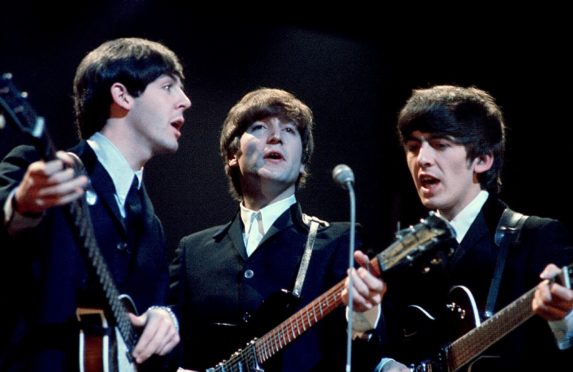
When the Fab Four came out of the theatre to hundreds of screaming fans lining the street, they must have had a feeling it was the start of something huge.
John, Paul, George and Ringo had just appeared on a TV show called Val Parnell’s Sunday Night At The London Palladium, with a weekly audience of around 18 million tuning in.
The Beatles had already had three No 1 hits and had often been on TV, but largely teenage shows. This was their first big family show – and it paid off.
The group topped the bill that night, closing the hour-long show. They began with From Me To You followed by I’ll Get You, which was introduced by Paul McCartney with some jovial interjections from John Lennon.
Their most recent hit, She Loves You, was next, announced collectively by Lennon, McCartney and George Harrison.
Then came the finale. Paul McCartney attempted to announce it, but was drowned out by the screams from the frenzied audience. Lennon jokingly told them to “shut up”, a gesture which was applauded by the older members in the audience. McCartney then asked them all to clap and stamp their feet, and they began Twist And Shout.
The Beatles’ appearance featured on the ITN news, complete with footage from the group’s dressing room.
Reporters wrote breathless front-page stories about the enthusiasm of the group’s screaming fans. It was so intense that the word “Beatlemania” was coined.
The group’s status as a new phenomenon was confirmed, with Beatlemania dominating the airwaves and press for years to come.
Beatlemania surpassed any previous examples of fan worship in its intensity and scope. Initially, the fans were predominately young, adolescent females, sometimes called “teenyboppers”, and their behaviour was scorned by many commentators.
By 1965, their fanbase included listeners who traditionally shunned youth-driven pop culture, which helped bridge divisions between folk and rock enthusiasts.
During the 1960s, Beatlemania was the subject of analysis by psychologists and sociologists and in 1997, a study recognised the phenomenon as an early demonstration of proto-feminist girl power. The receptions of subsequent pop acts – particularly boy bands – have drawn comparisons to Beatlemania, although none have replicated the breadth and depth of the Beatles’ fandom nor its cultural impact.
And it’s still a popular topic today.
Just last month, a new book, Beatlemania: 1963-1965 Four Photographers On The Fab Four was published.
Featuring the photography of Norman Parkinson, Terry O’Neill, Michael Ward, and Derek Bayes, it tells the life of the famous four through their lenses.
The work of the photographers in capturing the group during this historic period is being opened to Beatles fans.
The book provides a new perspective on an unforgettable era and reveals unknown images from the Beatles’ unsurpassed rise to global fame.
Even though The Beatles have gone, their legacy will live on for a very long time to come.

Enjoy the convenience of having The Sunday Post delivered as a digital ePaper straight to your smartphone, tablet or computer.
Subscribe for only £5.49 a month and enjoy all the benefits of the printed paper as a digital replica.
Subscribe